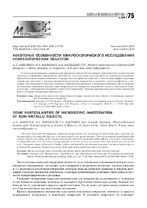| dc.contributor.author | Анисович, А. Г. | |
| dc.contributor.author | Маркевич, М. И. | |
| dc.contributor.author | Малышко, А. Н. | |
| dc.coverage.spatial | Минск | ru |
| dc.date.accessioned | 2020-06-12T12:33:09Z | |
| dc.date.available | 2020-06-12T12:33:09Z | |
| dc.date.issued | 2020 | |
| dc.identifier.citation | Анисович, А. Г. Некоторые особенности микроскопического исследования неметаллических объектов = Some particularities of microscopic investigation of non-metallic objects / А. Г. Анисович, М. И. Маркевич, А. Н. Малышко // Литье и металлургия. – 2020. – № 2. – С. 75-80. | ru |
| dc.identifier.uri | https://rep.bntu.by/handle/data/73633 | |
| dc.description.abstract | В статье рассматривается сравнительное применение оптической и растровой микроскопии для неметаллических объектов и непроводящих поверхностей. Отмечается, что этот вопрос мало освещается в специальной литературе. Практически отсутствуют публикации, в которых было бы проведено сравнение и описание фотографий структуры материалов, полученных с помощью принципиально различных микроскопов, в частности, металлографических и растровых. Рассматриваются причины искажения изображения в растровом электронном микроскопе при исследовании диэлектриков. Приводятся сравнительные изображения оксидированной поверхности, тканей и натуральной кожи, полученные с использованием растровой и оптической микроскопии. Показаны преимущества оптической микроскопии при исследовании непроводящих поверхностей. | ru |
| dc.language.iso | ru | ru |
| dc.publisher | БНТУ | ru |
| dc.title | Некоторые особенности микроскопического исследования неметаллических объектов | ru |
| dc.title.alternative | Some particularities of microscopic investigation of non-metallic objects | ru |
| dc.type | Article | ru |
| dc.identifier.doi | 10.21122/1683–6065–2020–2-75-80 | |
| local.description.annotation | The article deals with the comparative application of optical and raster microscopy for non-metallic objects and non-conducting surfaces. It is noted that this issue is not covered much in the special literature. There are practically no publications that compare and describe photos of the structure of materials obtained using fundamentally different microscopes, in particular, metallographic and raster. The causes of image distortion in a raster electron microscope in the study of dielectrics are considered. Comparative images of the oxidized surface, fabrics and natural leather obtained using raster and optical microscopy are presented. The advantages of optical microscopy in the study of non-conducting surfaces are shown. | ru |

